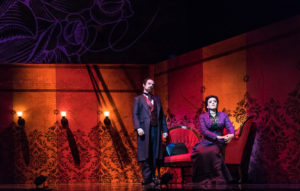
Chicago Opera Theater 2017-18 Review: Elizabeth Cree: A Masterpiece Hits the Stage in Potent Fashion
By Marjorie M. RuscheThe Chicago Opera Theater presented a stellar performance of “Elizabeth Cree” on Feb. 10, 2018, at the Studebaker Theater in Chicago’s Fine Arts Building. A co-production with Opera Philadelphia, this murder mystery opera based on Peter Ackroyd’s historical crime novel, “The Trial of Elizabeth Cree,” treads a knife-edge, successfully balancing horrific dramatic narrative, tongue-in-cheek vaudeville, and bittersweet pathos.
Mark Campbell’s text is brilliant and the music is beautiful, with composer Kevin Puts obtaining maximum musical effect with minimal instrumentation, particularly in the opera’s prologue and in the subsequent murder scenes. The opera, set in 1880s Victorian London, is structured into an intermission-less 29 scenes of 95 minutes duration. Clear and quick-paced staging by David Schweizer clarifies the opera’s circular dramatic structure and sudden stylistic shifts, aided and abetted by the striking lighting and projections designed by Alexander V. Nichols and the scenic and costume design by David Zinn. The conductor Geoffrey McDonald successfully integrated all of the gifted soloists, chorus, and orchestra in performance, with music advisor assistance from Francesco Milioto.
A New Kind of Heroine
Our heroine, Elizabeth Cree, physically escapes her mother’s sexual abuse (her father is nowhere in sight and never mentioned), finds another home and professional success by joining a rag-tag music hall variety theater troupe, leaves the stage for the assumed safety of marriage to playwright/critic/gentleman John Cree (the ear-pleasing baritone Christopher Burchett), but ultimately cannot escape her bloodlust bred from years of childhood hurt. Portrayed very ably by warm-voiced mezzo Katherine Pracht, the role would benefit from having Cree sung bigger, as a feral force with a nasty edge – especially during her final confession.
A Comic Tenor
Tenor Richard Troxell excelled singing the role of comedian Dan Leno. With a wide range of tone colors in his vocal arsenal, he easily shifted musical styles from the ironical and extroverted music hall number with the big waltz boom-chuck-chuck of “What’s going on down below, Mr. B.” to the somber lyricism of “O Woeful World.”
Opposing attorneys Mr. Lister (bass-baritone Vince Wallace) and Mr. Greatorex (baritone Bill McMurray) sonorously duke it out at Elizabeth Cree’s murder trial, proffering opposite conclusions from the same evidence (real news or fake news?).
Rondo Form
The whole work has dramatic and musical elements of Rondo form. Characters say “Here we are again,” a murder trial is happening but yet scenes move back and forth in time – it is not a strictly linear presentation of events. Large sections of musical material return, sometimes in a different key area. The opening of Scene six, where Inspector Kildare is on the hunt for the murderer – a B flat insistent ostinato pitch punctuated with short chordal motives on and off beat giving a type of restless, rhythmic urgency — returns in the opening and end of Scene 10 (again associated with Inspector Kildare, this time the ostinato pitch is B instead of B-flat), the middle to end of Scene 14 (with ostinato pitch of D) again coinciding with the appearance of Kildare. Kildare’s sound-world, the “hunting, tracking, uncovering music associated with murder or discovering murder” also appears in varied form in the accompaniment of Scene 16 where Uncle is speaking with Elizabeth about her courtship with Mr. Cree, and inquiring if she has told Mr. Cree about her unsavory habit of wandering London in male clothing. It also reoccurs in modified form the opening of Scene 23, where Elizabeth tells Aveline to give Mr. Cree a gentle physic for his bad dreams. The score is very tightly unified.
Through large stretches of music the post-tonal sound-world of Elizabeth Cree is full of various types of arpeggiated 7th chords – especially the MM7th chord and mM7chords (reminiscent of the e-flat mM7th chords arpeggiated in contrary motion in the opening of Hitchcock’s/Bernard Herrmann’s Vertigo) or two keys being arpeggiated at the same time. The instrumental figuration is Classical Period – almost Alberti-bass like and quasi-minimalistic, simultaneously repetitive and restless. Frequently the harmonies in each measure are bitonal (in two different keys, often with the chord root a Major or minor 2nd apart) which then move to a new harmonic area a Major or minor 3rd away – reminiscent of late Romantic period harmony, with the transitions held together by one repeated pitch. Noticeably lacking are Mm dominant sevenths – which usually function to establish tonality within a secure aural world, probably because Elizabeth Cree inhabits a world of great insecurity.
There is an ingenious mixture of expressionistic opera, music theatre, art song and film music styles throughout the opera.
Upcoming performances of “Elizabeth Cree” by Chicago Opera Theater are Friday, February 16 at 7:30 p.m. and Sunday, February 18 at 3:00 p.m. “Elizabeth Cree” is performed in English with English supertitles. Go see the show (a rom-com it’s not, but you could still bring your valentine).


